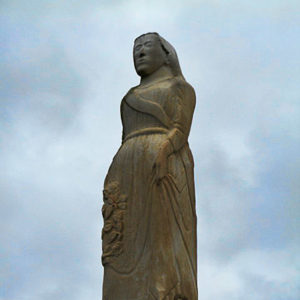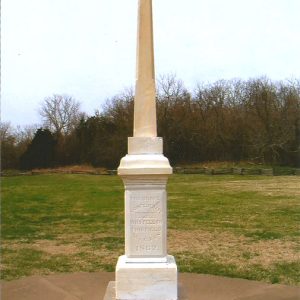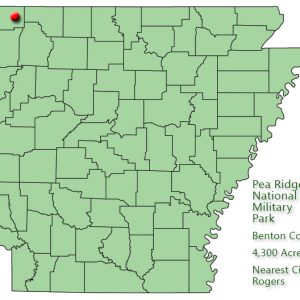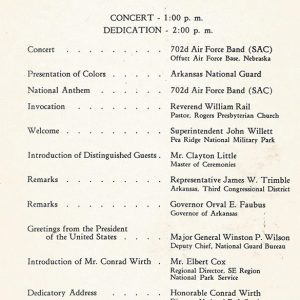calsfoundation@cals.org
Pea Ridge National Military Park
Located near Rogers (Benton County), the 4,300-acre Pea Ridge National Military Park was created by an act of Congress in 1956. The park, which preserves the battlefield of the 1862 Battle of Pea Ridge, was dedicated as a national park during the nation’s Civil War Centennial in 1963. Pea Ridge is one of the best-preserved Civil War battlefields in the country.
The Pea Ridge National Military Park came into being through the work of several Arkansas congressmen. Representative Clyde T. Ellis of Arkansas’s Third Congressional District began corresponding with the National Park Service in 1939, reviving a proposal to preserve the Pea Ridge battlefield. In 1956, the Arkansas congressional delegation proposed legislation to make Pea Ridge a national military park. This was a major breakthrough in Civil War battlefield preservation. At that time, under the National Park Service classification system, only one acre should have been preserved, along with a monument. On July 20, 1956, Congress enacted legislation to accept a 5,000-acre donation from the state of Arkansas.
In 1958, under the umbrella of the Benton County Historical Society, Mrs. W. W. Vaught of Fayetteville (Washington County) proposed the formation of the Pea Ridge Memorial Association. The association was approved in 1961 to hold yearly memorial services on each anniversary of the Battle of Pea Ridge. In addition, the group’s purpose was to install historic markers on sites closely connected with the maneuvers of both armies before and after the battle. The park was listed on the National Register of Historic Places on October 15, 1966.
Many Union and Confederate veterans attended several reunions at the Pea Ridge battlefield long before it was a park. The first of these reunions was held in 1887, twenty-five years after the battle. The reunions promoted not only remembrance, but healing. The veterans dedicated the first monuments on the battlefield to both the Union and Confederate dead. These monuments are located within the park today.
Featured areas of the park include the re-creation of the historic Elkhorn Tavern, which was the scene of the two-day battle’s heaviest fighting; remnants of the original section of the Telegraph/Military Road, an important thoroughfare prior to the war; and the battlefield itself. The park also contains approximately two-and-a-half miles of the Trail of Tears as followed by some members of the Cherokee Nation. In February 2010, a $1 million renovation, including an expanded museum with interactive exhibits, was opened to the public. In 2023, the Conservation Fund donated the 140-acre Green homestead, which lies within the boundaries of the park and which the fund had acquired in 2020, to the Pea Ridge National Military Park.
The park is administered by the National Park Service, Department of the Interior. The Pea Ridge National Military Park is a part of the Civil War Discovery Trail, the Lower Missouri Civil War Heritage Trail, and the Trail of Tears National Historic Trail.
For additional information:
Boge, Georgie, and Margie Holder Boge. Paving over the Past: A Guide to Civil War Battlefield Preservation. Washington DC: Island Press, 1993.
Civil War Preservation Trust. The Official Guide to Battlefields, Monuments and More. Gilford, CT: The Globe Press, 2003.
Greene, A. Wilson, and Gary W. Gallagher. National Geographic Guide to Civil War National Battlefield Parks. Washington DC: National Geographic Society, 1992.
Pea Ridge National Military Park. http://www.nps.gov/peri/ (accessed January 25, 2023).
Rosenbaum, Bethany H. “Promise and Practice: Toward an Expanded, Integrated, Collaborative Narrative on American Indians in our National Parks.” PhD diss., University of Arkansas, 2019.
Shea, William, and Earl Hess. Pea Ridge: Civil War Campaign in the West. Chapel Hill: University of North Carolina Press, 1992.
Skirmishes around Bentonville and Little Sugar Creek Preceding the Battle of Pea Ridge. Bentonville, AR: Benton County Historical Society, 2000.
Steven L. Warren
Virginia Beach, Virginia
 Daniel, Lucy Jane
Daniel, Lucy Jane Goddess of Liberty
Goddess of Liberty  Pea Ridge Confederate Monument
Pea Ridge Confederate Monument  Pea Ridge Confederate Monument
Pea Ridge Confederate Monument  Pea Ridge National Military Park: Park Location
Pea Ridge National Military Park: Park Location  Pea Ridge National Military Park
Pea Ridge National Military Park  Pea Ridge National Military Park Battlefield
Pea Ridge National Military Park Battlefield  Pea Ridge Dedication
Pea Ridge Dedication 




Comments
No comments on this entry yet.